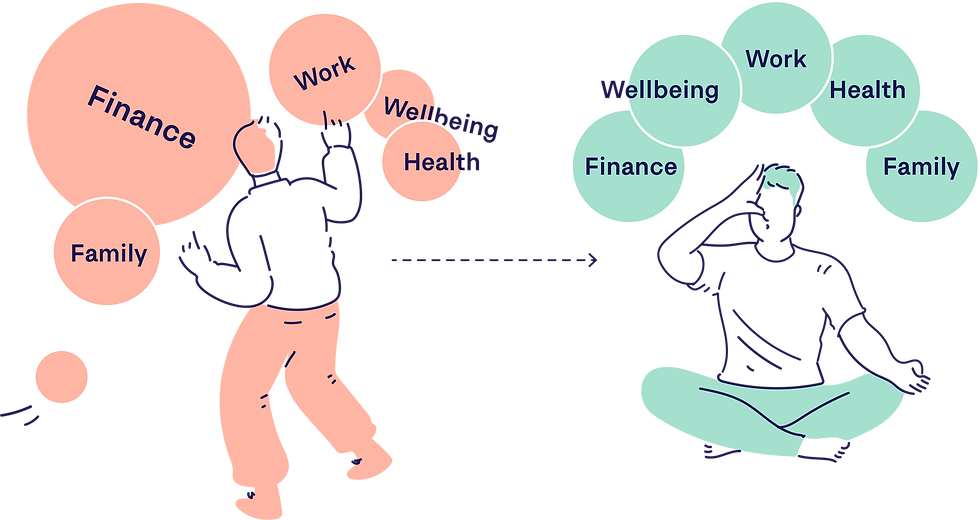From Survival to Executive State: The Hidden Shift That Unlocks Breakthrough Leadership
- Ron Adiel

- Apr 29
- 3 min read
Updated: May 17
Have you ever found yourself making dozens of consecutive decisions, pushing through long hours, and achieving results—yet still feeling reactive, your mind scattered, and your energy drained?
That’s not just exhaustion. It’s a signal that you may be operating from the Survival State—a state that may deliver short-term output, but comes at a steep emotional cost and leads to suboptimal long-term outcomes.
What if there’s a way to lead that’s not only more centered and fulfilling—but far more effective?

The Two States That Shape How You Lead
The state you're in determines the leader you become.
In what we call the Survival State, your brain and body are operating under perceived threat. Awareness narrows. Your system slips into reactivity mode.
You may appear productive—but you’re resisting the present, driven by the inner currents of fight, flight, or freeze.
Burnout accumulates. Creativity declines. Strategic clarity blurs.
It's as if someone, or something, is constantly pushing your buttons.
The Executive State, as defined in the Lifetime Evolution Framework, is your true power zone: calm, steady, and expansive.
From this state, leaders attain:
Clarity of thought
Emotional regulation
Presence and steadiness under pressure
Creative thinking and innovation
Deep focus on what truly matters
Fulfillment, inspiration, transcendence
The Executive State is where you stop reacting and start to proactively choose.
Lion Mind vs Monkey Mind: Gaining Inner Mastery
Drawing from Eastern wisdom, we use a simple but powerful metaphor:
Monkey Mind = frantic, scattered, survival-driven
Lion Mind = calm, observant, purpose-aligned
When you're in Monkey Mind, every trigger or notification feels urgent. You're hyper-alert, primed to react.
In Lion Mind, stillness is your default. You observe first. You remain composed. You act with intention.
Stillness isn’t passivity—it’s where your greatest clarity is born.
The Neuroscience of the Executive State
The Lion Mind reflects the Executive State, and there’s a reason it feels different: it involves different brain networks.
In the Survival State, the amygdala and limbic system take the lead. These ancient brain regions evolved long before rational thought, designed to activate emotion and trigger rapid response—ideal in the wild, but often counterproductive in today’s complex leadership environment. They hijack thoughtfulness and clarity in favor of urgency.
In the Executive State, a different network takes control:
The prefrontal cortex, home to the brain’s Executive Function, engages to support thoughtful planning, reflection, and optimal decision-making.
The parasympathetic nervous system engages, promoting calm, presence, and creative flow.
Together, these systems empower you to regulate negative emotions, stay grounded under pressure, and engage in strategic, value-driven thinking.
This is the biology behind purposeful leadership. And it’s not theoretical—it’s trainable.
Why This Shift Matters for Executive Leadership
Today’s executives are under relentless pressure—from investors, clients, teams, and their own self-imposed expectations. The instinctive response is to move faster, do more, and push harder. But that only reinforces the Survival State.
This reactive mode diminishes effectiveness precisely when it’s most needed:
Urgency overrides what’s important
Stress clouds long-term vision
Decisions become ego-protective
The Executive State flips the equation:
You lead with intent, not reactivity
You inspire calm and confidence in others
You access creative breakthroughs
You preserve energy and avoid burnout
This is the essential shift:
Order over chaos. Intention over reactivity. Lion over Monkey.
And it doesn’t happen by accident.
This shift into the Executive State is a central component of the Lifetime Evolution Framework—our holistic model for cultivating transformational leadership from the inside out.
Self-Leadership: The Gateway to the Executive State
The Executive State is not stumbled upon. It is the result of deliberate Self-Leadership.
That means:
Mastering emotional regulation
Empowering positive habits and beliefs to support your highest potential
Cultivating uplifting emotional states
Aligning with your North Star
This is the kind of leadership that transforms not only individuals, but entire organizations—by elevating how leaders think, act, and influence under pressure.
A Closing Reflection
What would shift in your leadership if you no longer acted from triggers, but from clarity and intention?
How would it feel to navigate complexity not from survival, but from steady, purpose-driven awareness?
The journey from Survival to Executive State is not only accessible—it’s essential. Not a luxury, but a prerequisite for sustained, impactful leadership.
And it begins by leading the one person you’ll be guiding for life: yourself.
(The next post will explore Self-Leadership more deeply—what it is, how to develop it, and why it’s the foundation for breakthrough leadership.)
Curious how to evolve into the Executive State?
Discover how the Lifetime Evolution Program can transform the way you lead, think, and feel.
The Executive State, Survival State, and related terms are part of the proprietary Lifetime Evolution™ Framework.
About the Author
Ron Adiel, PhD, empowers CEOs, Founders, and CXOs to achieve holistic transformational growth through the Lifetime Evolution Program, which integrates executive leadership expertise, psychology, and neuroscience.


